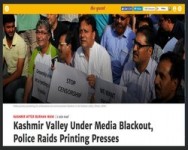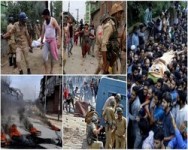Kashmiris turn against media, local journalists affected
Srinagar: On Friday, Shah Faesal, member of the IAS (in 2009 he became the first Kashmir to top the civil service exam in Kashmir) and Director of School Education, threatened to resign over some Indian news channels’ ‘propaganda” in drawing parallels between him and slain Hizbul Mujahideen commander Burhan Wani.
During reporting on the ongoing unrest, NDTV, Zee News and NewsX juxtaposed Faesal with Wani, declaring the former a role model for Kashmir’s younger generation.. Wani was killed on July 8 and his death triggered a violent eruption of unrest, with 44 people dead in street clashes between protesters and security forces.
Faesal threatened to “resign sooner or later” and attacked the channels. “By juxtaposing my photos with the images of a slain militant commander, a section of the national media has once again fallen back upon its conventional savagery that cashes in on falsehoods, divides people and creates more hatred,” he wrote on his Facebook page.
Faesal, who is a doctor by training, told the Hoot that the channels which had been running this ‘story’ would force him to go back to the medical profession. “At a moment when Kashmir is mourning its dead, the propaganda and provocation being dished out from red and blue newsrooms is breeding more alienation and anger in Kashmir than what the Indian state can manage,” he said. “Have I joined the IAS to do a job or to become a part of your sadistic propaganda machine? In fact when I qualified this exam I never thought of spending my whole life scratching the desk and if this nonsense around me continues, I might prefer to resign sooner than later.”
Faesal is not alone in declaring the Indian media to be a “propaganda machine”. Ordinary Kashmiris have similar complaints. Since last Friday when Wani was killed, journalists have complained of facing a hostile public on one end and government forces on the other.
Last week, when a photojournalist working with an international news agency was clicking shots at Shri Maharaja Hari Singh Hospital, a group of youths heckled him, forcing him to retreat. He displayed his identity card and tried to explain that he does not “distort” or “mislead” but the youths refused to relent.
In fact, the angry youths were looking for news channel crews. “They show misleading reports. Bring them here,” a young boy told him.
At the Hospital’s Ward No. 8, I was talking to patients who suffered pellet wnds, some of whom have gone blind in one eye, and also talking to an NDTV reporter. Some youths were roaming around looking for an NDTV reporter and when they saw us, shouted at me: “Who is this NDTV?”
Fearing problems, we both left the ward. Other journalists experienced similar anxiety. Senior news channel reporters told me they were not carrying their press cards lest it invite public ire.
On Friday afternoon, on seeking details from the attendants of a wounded youth from Sopore, I was pushed to leave the spot. Protestors tried to find my identity card and when they found it, tore it in half and tried to assault me in the presence of my editor. Later, my colleagues told me they had kept silent and avoided the suspicions of attendants by doing their work separately and not in a group.
This tense situation for reporters is the outcome of media outlets such as PTI, Times Now, NewsX, and India Today TV, distorting the facts. India Today TV claimed that youths are being paid by “terrorists” to throw stones while running old video footage in the background either from the 2008 or 2010 protests while telling viewers that “India Today is only channel reporting from ground zero”. A youth detained by the security forces was shown claiming that separatist leader Syed Ali Shah Geelani paid him Rs 500 to spread “mayhem”.
I will not go into the question of whether the separatists pay stone throwers or not. The point is, did Geelani foresee Wani’s death or that Kashmir will explode like this? No. Everyone was caught unawares. Even the Jammu and Kashmir government was not prepared for such a spontaneous reaction otherwise they would have enforced a communication blockade from day one.
PTI carried a story that a police official’s wife and daughter were beaten up by people in south Kashmir’s Awantipora area in Pulwama district on July 12. The story quoted anonymous officials. Yet the Superintendent of Police Awantipora, Shridar Patil, denied on record that any such incident had occurred.
When journalists dish out factually incorrect reports, problems are bound arise for the fraternity as a whole. A journalist working with Rising Kashmir, Danish Nabi, was assaulted by people for these inaccuracies. Similarly, other journalists had to face hostile crowds.
Leave aside stories of boys who are “paid” agents. What I would like to know is who paid 5-year-old Zohra Farooq who was showered with pellets in her legs and abdomen? Or the 6-year-old girl called Insha who was blinded and maimed by forces in south Kashmir’s Shopian? Or Sara Begum, 78, who was left crippled by injuries at Anantnag hospital after receiving a beating from the security forces?
What these journalists sitting in studios don’t tell their viewers is that Chief Minister Mehbooba Mufti confessed that excessive force was used against protestors. Is it so very strange that killings invite anger and protests? As Faesal rightly pointed out, propaganda only serves to create more hatred.
Moazum Mohammad is a Srinagar-based journalist working at the Kashmir Reader. Earlier, he worked with the Pioneer. He tweets @moazum_m









